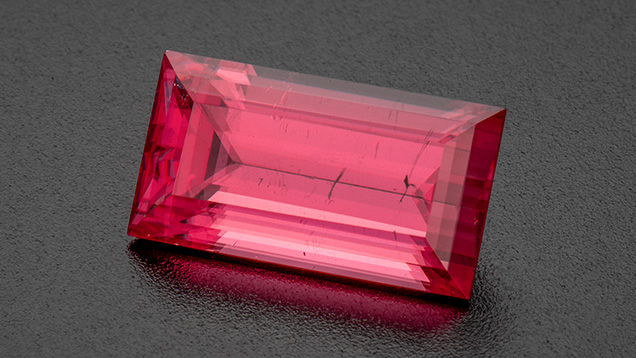Sweet Home Mine Rhodochrosite from 1888

At AGTA, Ann Barker and Tori Lopez of Barker & Co. (Scottsdale, Arizona) exhibited a 7.94 ct rectangular step-cut rhodochrosite (see above) with a provenance dating back more than a hundred years. The stone is from the Sweet Home mine in Colorado’s Alma Mining District, at an elevation of about 3,300 m in the Rocky Mountains.
Sweet Home was established as a silver mine in 1872. Miners initially discarded most of the rhodochrosite found in association with the silver ore because it interfered with the amalgamation process used then in silver mining. But the large, highly saturated, and nearly perfectly formed crystals later discovered there are some of the world’s finest rhodochrosite specimens.
Rhodochrosite was first described in the mineralogical literature in 1813 based on specimens from what is now Romania. In 1887, George F. Kunz wrote of gem-quality rhodochrosite in Colorado, noting it was the first source with such large and transparent crystals. Most of the rhodochrosite available worldwide was light pink, opaque, and often banded—typically used for beads, cabochons, and carvings. This source introduced pink to red gem-quality single-crystal rhodochrosite, which is rare. The gemstone became more widely known in the late 1930s, after a German gemologist found large volumes in Argentina’s Catamarca Province high in the Andes. (In Argentina, the use of rhodochrosite dates back to the ancient Incas, who are said to have believed it was the solidified blood of their fallen rulers.)
The step-cut stone’s traceable history began in 1888, when a shaft collapse resulted in a 32.61 ct cleavage fragment. Miner Edward Abbott kept it and in 1925 gave it to Denver businessman Edwin Spray, who later owned the mine. The same year, Sweet Home miners found large specimens on quartz matrix, many of which were sold to museums in the U.S. and Europe. In 1968, the fragment made its way from Spray’s widow, Eleanor, through a friend of the family to geologist and mineral collector Charles Trantham in California. In 1981, Glenn Vargas, a gem and mineral dealer and university instructor, expertly cut the stone. Rhodochrosite often presents challenges for cutting due to its low hardness (3.5–4.0 on the Mohs scale) and perfect rhombohedral cleavage.
Rhodochrosite mining at Sweet Home expanded significantly in 1991—long after silver production ended in the 1960s—when Eleanor Spray’s nephew, F. Leonard Beach, leased the property to a group of investors led by Collector’s Edge Minerals. The group found several new pockets and in 1992 uncovered the Alma King, a 14.2 × 16.5 cm deep cherry red rhombohedron, the world’s largest known fine rhodochrosite crystal.
The Sweet Home mine closed in 2004, but the group went on to develop the associated Detroit City mine, which has produced some fine specimens since 2019.



